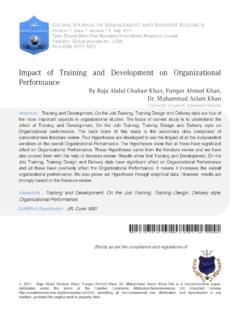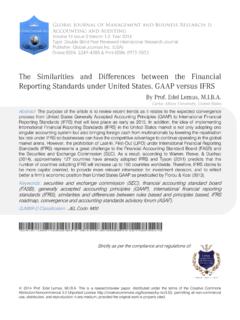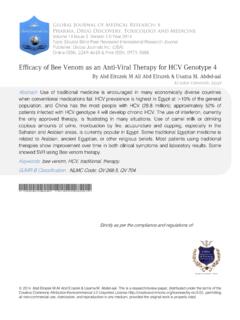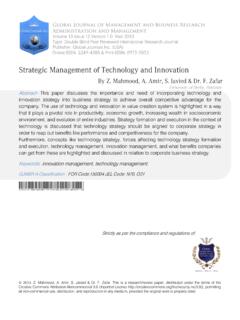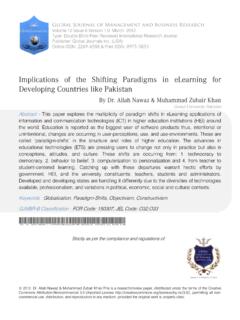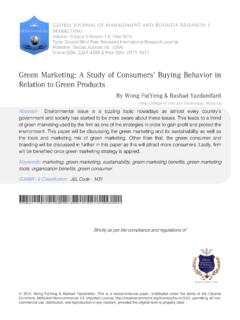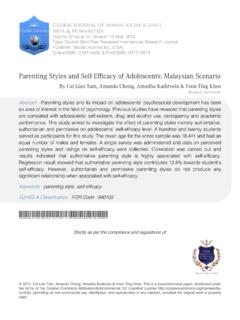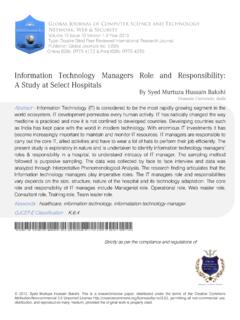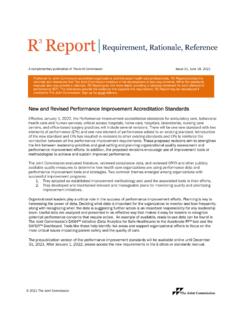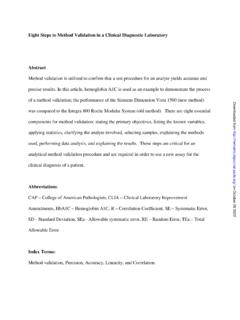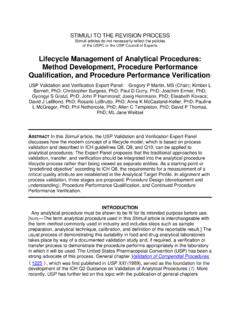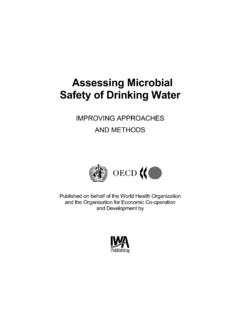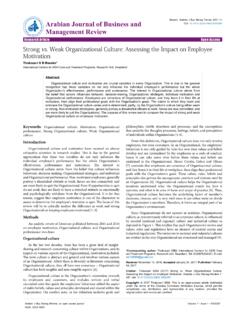Transcription of How Effective Leadership can Facilitate Change in ...
1 2015. Moo Jun Hao & Dr. Rashad Yazdanifard. This is a research/review paper, distributed under the terms of the Creative Commons Attribution-Noncommercial Unported License ), permitting all non-commercial use, distribution, and reproduction in any medium, provided the original work is properly cited. Global Journal of Management and Business Research: A Administration and Management Volume 15 Issue 9 Version Year 2015 Type: Double Blind Peer Reviewed International Research Journal Publisher: Global Journals Inc. (USA) Online ISSN: 2249-4588 & Pr int ISSN: 0975-5853 How Effective Leadership can Facilitate Change in Organizations through Improvement and Innovation By Moo Jun Hao & Dr. Rashad Yazdanifard Southern New Hampshire University, Malaysia Abstract- This research intends to explain Effective Leadership and how it can bring positive Change that helps the organization to improve and be innovative in the current business environment.
2 Effective Leadership and Change management will be discussed in this article and also how Leadership affects other factors, for instance trust, culture and clear vision, in the organization as it facilitates the Change . Leadership is one of the main factors in bringing positive Change to the organization; if there is no Leadership in the organization they will not be able to Change in the direction they desire and could experience negative Change instead. Keywords: Leadership , Change management, improvement, innovation. GJMBR - A Classification : JEL Code: M10 HowEffectiveLeadershipcanFacilitateChang einOrganizationsthroughImprovementandInn ovation Strictly as per the compliance and regulations of: How Effective Leadership can Facilitate Change in Organizations through Improvement and Innovation Moo Jun Hao & Dr.
3 Rashad Yazdanifard Abstract- This research intends to explain Effective Leadership and how it can bring positive Change that helps the organization to improve and be innovative in the current business environment. Effective Leadership and Change management will be discussed in this article and also how Leadership affects other factors, for instance trust, culture and clear vision, in the organization as it facilitates the Change . Leadership is one of the main factors in bringing positive Change to the organization; if there is no Leadership in the organization they will not be able to Change in the direction they desire and could experience negative Change instead. Keywords: Leadership , Change management, improvement, innovation. I. Introduction he rapid growth of the economic environment as well as the emergence of the internet made it easier to communicate with countries around the world.
4 This in turn changed the business environment in every country, causing a competitiveness in the market that increases with each passing year (Friedman, 2007). In order to keep their business afloat, business owners discovered they had to offer better quality products at a lower cost, employ strategies that were uniquely suited for the organization to adapt according to current business trends and also flexibility in facing the rapid Change of the business environment. Effective Leadership is one of most essential parts of the overall method for an organization to sustain their business in the face of problems caused by the rapid growth of the economic environment. ( Cabeza-Erikson, Edwards, and Van Brabant, 2008) Leaders are the one who control and take charge of the operation of an organization and good leaders are able to set optimistic goals and objectives while steering the operation of the company towards those goals through Effective strategies.
5 Other than that, good leaders can also influence their employees and motivate them by strengthening a positive organization culture and through generous employee benefits, for instance health care insurance, worker compensation, leave benefit and others. Author : Center of Southern New Hampshire University (SNHU Program), Help College of Arts and Technology, Kuala Lumpur, Malaysia. e-mails: Intelligent leaders also have the responsibility to use their skills and knowledge to effectively and efficiently guide their business forward in the face of an uncertain future and also to decrease the feelings of insecurity in their employees caused by that uncertainty. A leader has the power to influence the success of the organization, due to his full power to control the direction of the organization, as well as through the influence they exert on th eir employees that motivates them to bring the company to greater heights.
6 II. Effective Leadership Leadership is a kind of power where one person has the ability to influence or Change the values, beliefs, behaviour and attitudes of another person (Ganta, and Manukonda, 2014). A person with strong Leadership ability will be a good example or role model to their employees, because the leader who is able to effectively achieve some good result or achievement gains the trust and admiration of their employees, and inadvertently changes their values, beliefs, behaviour and attitudes, for mimicry is the sincerest form of flattery (Grint, 2007). This statement is also supported by Northhouse (2009), who states that leaders who possess strong Leadership have the strength to influence others to achieve the goals and objectives of the organization. Other than that, there is also another way to define a leader that has strong Leadership .
7 A characteristic of Effective leaders is that they give a clear direction to their employees, and also lead their employees to commit to their jobs and to work as a group to achieve the organization s goals and objectives (Wasim, and Imran, 2010). This also tells us that good leaders usually have a clear vision for the company and therefore can easily identify the problems and obstacles that currently stand between them and the aims of the organization. In this way they are able to effectively and efficiently bring about the necessary reforms that will bring the company into the future while keeping abreast with contemporary changes in the business world. According to Jackson and Parry (2008), Leadership is a process where leaders use their skills and knowledge to lead and bring a group of employees in the desired direction that is relevant to their T 2015 Global Journals Inc.
8 (US)1 Global Journal of Management and Business Research Volume XV Issue IX Version IYear 2015()A organization s goals and objectives. Additionally, an Effective leader that has strong Leadership skills should also be in possession of certain characteristic, such as, passion, consistency, trust and vision; for only leaders who own these characteristics are able to build trust in employees. Leadership and management are two different aspects, management is more like the traditional way of managing business, which the owner of the business has complete control of the organization, and will single-handedly establish a direction and direct their employees to do their work in accordance to the owner s instruction and plan. On the other hand, Leadership is when the leader guides their employees towards the organizational goals, all the while trying to communicate and motivate their employees in order to make sure their employees are in the right position to use their talents and commit to their jobs.
9 Leadership strategies also will Change according to the current trends when necessary, unlike management that merely follows it s old, traditional rules. (Graetz et al., 2010) III. Change Management Change has always been an issue for organization, just as it has always been a common characteristic of human life. Change is definitely hard for humans to accept as it is something that pull people out of their comfort zones, which forces them to Change their habits and makes them highly uncomfortable (Lorenzoni, Nicholson, and Whitmarsh, 2007). For example, a worker usually starts work at 9 ; if his supervisor suddenly requests the worker to begin work at 7 , the worker will be late to work because force of habit keeps him waking up late. The same thing applies to the organization, if an employee s normally does their work following the sequence of A to Z, suddenly changing the sequence of work from Z to A, can be quite difficult for all the employees to get use to in a short period of time.
10 Change management in an organization can be defined as an approach to deal with Change in two different areas - the organization and the individual, with individuals and the overall organization adapting to Change at their own pace and style (Rouse, 2014). Change management allows the organization to catch an opportunity to gain a competitive advantage, if the organization effectively and efficiently implements and adapts to the Change of the market (Du Plessis, 2007). There are three stages in Change management, which are adapting to Change , controlling the Change and lastly effecting the Change . The first stage, adapting to Change , is determining the individual readiness to adapt to the changes and their willingness to commit to the Change . The second stage involves controlling the Change and implementing it in daily life. Lastly, effecting the Change , is to sustain the Change and to get used to it in life.

